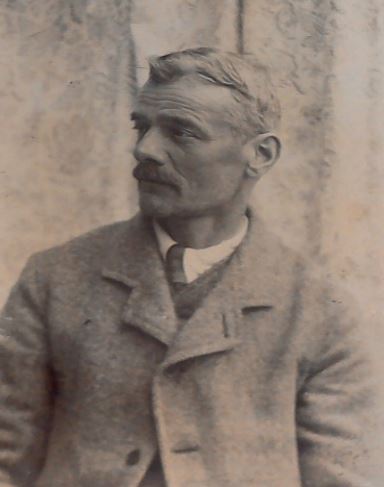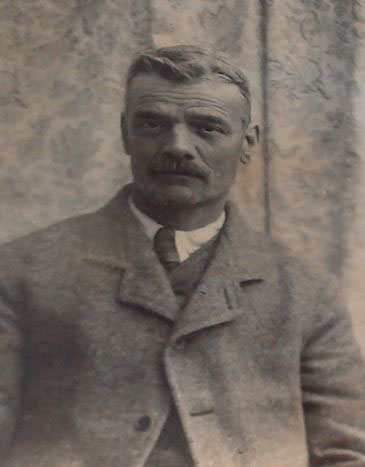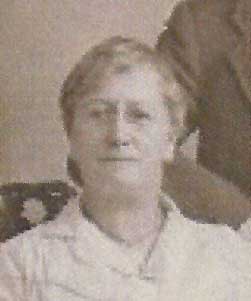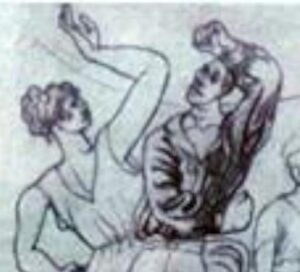b.1855 – d.1913
Intro
The original life story of George is written by Sylvia Bromiley, which ended on George entering the Colony. Since publishing, a further detailed study of George at the Colony was found.
The part of the story that details Ewell Epileptic Colony has been written by Sheila Cumming, who researched George for an article on the early patients of the Ewell Epileptic Colony as part of the Horton Chapel project. This is used with permission of the Horton Chapel Arts & Heritage Society.
Early Life
George was born in Q2-1855, birth was registered in the Marylebone registration district.
His mother was Margaret Matthews and his father was Edward Dodd. His parents married on 8th May 1843 and had 6 children. George was the only son. His 5 sisters, 2 of whom died in infancy, were:
- Elizabeth Mary Ann Born 1844
- Alice Ann Born 1848 (died the same year)
- Mary Ann Born 1849 (died 1850)
- Louisa Born 1851
- Rosanna Born 1857
According to the 1861 census the family lived in Wells Street, Marylebone, Middx and George’s father was a painter journeyman. Wells Street today is in the heart of a district known as Fitzrovia, some parts of which are very expensive.
The 1871 census shows George’s mother Margaret, by then a widow, her husband Edward having died in 1863 at the age of 42. Margaret is described as head of household and a “Cheesemonger” – a person that deals in cheeses, George was 15 and working as a machine boy, his sister Rosanna was described as a “servant”. They were living at 6 Saville Street in Marylebone, one of 11 families consisting of 42 people living at that address. Life must have been extremely difficult for the 3 people of the family still living together.

“Saville Street like Union Street and Upper Rathbone Place. Irish Cockneys. Good sprinkling of thieves and burglars, no mess in street, cobble paved.”
Booth’s maps and notebooks of London streets
George married Elizabeth Carter in 1879, she lived only a few doors away from George.

In the 1891 census George and Elizabeth and their growing family, George 10, Charles 8 and Frank 4, are living at 100 Whitfield Street which is still there today just west of Tottenham Court Road. George is described as a French polisher, a skilled tradesman and a step up from his father. Whitfield Street is not too far from Wells Street where George lived as a boy.
George and Elizabeth went on to have 6 children in all.
- George (Edward) Born 1880 (sometimes shown as Edward George)
- Charles Born 1883
- Frank Born 1887
- Edward Born 1889 (died 1889)

…and by 1901 census
- (Elizabeth) Rose Born 1892
- Arthur (Frederick) Born 1898
The 1901 census shows the family had moved to Islington and shows George’s eldest son, Edward George became a French Polisher like his father and Charles a Wood Machinist (Sawyer) and Frank an Errand Boy.

The condition of epilepsy did not become apparent in George’s life until he was almost 50 years of age. Prior to this his only serious illness had been scarlet fever and he firmly believed this was the trigger for his new condition. Contemporary medical opinions (Gowers and Sieveking) draw links between the 2 conditions but later research notes that seizures experienced during scarlet fever are not necessarily symptomatic of epilepsy.
The first treatment George received for his epilepsy was upon admission to Colney Hatch Lunatic Asylum in December 1904. A year later he was allowed out on trial for a period of 6 weeks but then began to experience even more severe seizures.
Ewell Epileptic Colony
Colney Hatch was severely overcrowded and lacking in accommodation after a serious fire in 1903, so George was lucky to be transferred to the Colony in April 1906, where conditions were much better.
The Visitors Book for the Colony show that he was visited on numerous occasions by members of his family who travelled from as far away as Essex and Nottingham to see him.

The picture of George taken on admission shows a well-nourished, well-dressed man with groomed hair and moustache.
He gave a good account of himself when a case history was taken but he had little recollection of his admission to Colney Hatch or the events leading up to it. He became by turns tearful, trembling or irritable as he was interviewed, and claimed he had a bad memory.
It was noted that he indulged in alcohol and sexual activity to excess but did not have syphilis. It was not uncommon for case notes to contain moral judgements on the lifestyle of the patients.
George settled into the Colony well and was described as being useful when employed in mending and polishing furniture. Unfortunately, he sustained several tool injuries when caught unawares by seizures, so by 1908 he was transferred to the Colony farm, where he appeared to enjoy his role. His seizures were by now becoming more frequent and violent and happened mostly at night. He suffered shaking of the limbs, foaming at the mouth and hallucinations. Understandably these episodes left him upset and confused for long period afterwards and he sometimes was not aware that he had seizures.
His case notes make it clear that, having been fit and healthy until the age of 49 years, he found the diagnosis of epilepsy hard to accept. There seems to have been little medical intervention, other than the administering of laxatives and enemas, so George had to endure the very unpleasant symptoms of his illness.
The 1911 Census shows George DODD, aged 55, married, former French Polisher, born London Marylebone, the final column states Lunatic since aged 49.

George’s condition began to decline on the 7th April 1913, when he became ‘agitated, aggressive and resistive’. On 11th April 1913 he was confined to bed, showing signs of ‘fits, strenuous breathing and rigidity in the legs’. An enema was given, ‘with good result’.
George then fell into a coma, his blood pressure dropped and he finally died in the early hours of 12th April 1913, age 57. His cause of death was recorded as granular kidney, recent encephalitis (inflammation of the brain) and a large central haemorrhage of the brain.
George was buried 5 days later on 17th April 1913, he is buried in the Horton Cemetery in plot 543b.
Family beyond 1911
By the date of the 1911 census George’s eldest son was living in Denton, Lancashire and was working as a French polisher in the railway carriage building business.
The 1911 Census also shows that George’s wife Elizabeth, age 52, was living at 13 Saint Paul’s Road, Camden (today called Agar Grove) with her daughter Rose (Elizabeth Rose born 1892) age 19 and Arthur (born 1898) age 12. George, her husband was in the Epileptic Colony in Ewell, one of the Epsom Cluster hospitals. (There had been a murder at 29 Saint Paul’s Road, Camden in 1907 only 8 doors up from where Elizabeth lived with her children and lodgers in 1911. The murder was made more famous later when Walter Sickert, a famous British artist painted a series of pictures that became known as “The Camden Town Murder”. Apparently Sickert has been claimed to be Jack the Ripper by the author Patricia Cornwell.)
Authors (Sylvia) Notes
George was obviously not an imbecile or lunatic as he was a skilled worker – an experienced French polisher – who had worked for many years and successfully brought up a family and even had grandchildren. I would assume he only suffered from epilepsy, which perhaps only came on in later life.
At least 4 of George’s children married and went on to have children of their own. I have attached a family tree showing George’s grandchildren. Undoubtedly there will be living descendants of George around today.
I wonder if they know where and in what circumstances their ancestor was buried. (This note was written before the addition of the Colony source)
BIBLIOGRAPHY SOURCE
- Surrey History Centre records relating to the Ewell Epileptic Colony, Ref 6292/27/2/184
- BMD and census records – Crown Copyright
- Colney Hatch Asylum
- Barnet Local Borough History
- Sieveking E. (1858) Epilepsy and epileptiform seizures: their causes, pathology and treatment. John Churchill, London
- National Institute of Neurological Disorders and Stroke. University of South Florida School of Medicine: ”Psychogenic (Non-Epileptic) Seizures,” Selim R. Benbadis, MD, and Leanne Heriaud, RN, authors. WebMD Medical Reference Reviewed by Neil Lava, MD on May 05, 2019
- Gowers, William R. “Clinical Lectures On The Borderland Of Epilepsy: Vertigo.” The British Medical Journal, vol. 2, no. 2377, 1906, pp. 128–131. JSTOR, www.jstor.org/stable/20290513. Accessed 6 Feb. 2020
- Shorvon SD. (2011) Historical introduction: the causes of epilepsy in the pre molecular era (1960 – 1960) In Shorvon SD, Andermann f, Guerrini R (Eds) The causes of epilepsy. Common and uncommon causes in adults and children. Cambridge University Press, Cambridge, pp1-20
- Reed CAL. Constipation in Causation of Epilepsy and Migraine. JAMA. 1916;LXVI(12):912. doi:10.1001/jama.1916.02580380062034
- Records of Horton Cemetery burials – Epsom & Ewell Historical Explorer




